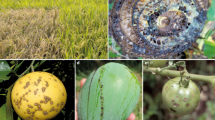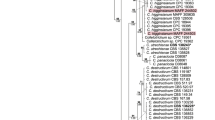Abstract
The genus Xanthomonas is a diverse and economically important group of bacterial phytopathogens, belonging to the γ-subdivision of the Proteobacteria. Xanthomonas axonopodis pv. citri (Xac) causes citrus canker, which affects most commercial citrus cultivars, resulting in significant losses worldwide. Symptoms include canker lesions, leading to abscission of fruit and leaves and general tree decline1. Xanthomonas campestris pv. campestris (Xcc) causes black rot, which affects crucifers such as Brassica and Arabidopsis. Symptoms include marginal leaf chlorosis and darkening of vascular tissue, accompanied by extensive wilting and necrosis2. Xanthomonas campestris pv. campestris is grown commercially to produce the exopolysaccharide xanthan gum, which is used as a viscosifying and stabilizing agent in many industries3. Here we report and compare the complete genome sequences of Xac and Xcc. Their distinct disease phenotypes and host ranges belie a high degree of similarity at the genomic level. More than 80% of genes are shared, and gene order is conserved along most of their respective chromosomes. We identified several groups of strain-specific genes, and on the basis of these groups we propose mechanisms that may explain the differing host specificities and pathogenic processes.
This is a preview of subscription content, access via your institution
Access options
Subscribe to this journal
Receive 51 print issues and online access
$199.00 per year
only $3.90 per issue
Buy this article
- Purchase on Springer Link
- Instant access to full article PDF
Prices may be subject to local taxes which are calculated during checkout


Similar content being viewed by others
References
Gottwald, T. R. & Graham, J. H. in Compendium of Citrus Diseases (eds Timmer, L. W., Garnsey, S. M. & Graham, J. H.) 5–7 (Am. Phytopathol. Soc., St. Paul, 2000)
Hayward, A. C. in Xanthomonas (eds Swings, J. G. & Civerolo, E. L.) 51–54 (Chapman & Hall, London, 1993)
Becker, A., Katzen, F., Puhler, A. & Ielpi, L. Xanthan gum biosynthesis and application: a biochemical/genetic perspective. Appl. Microbiol. Biotechnol. 50, 145–152 (1998)
Menestrina, G. & Semjen, B. V. in The Comprehensive Sourcebook of Bacterial Proteins Toxins (ed. Alouf, J. E.) 287–309 (Academic, London, 1999)
Simpson, A. J. et al. The genome sequence of the plant pathogen Xylella fastidiosa. Nature 406, 151–157 (2000)
Göttfert, M., Grob, P. & Hennecke, H. Proposed regulatory pathway encoded by the nodV and nodW genes, determinants of host specificity in Bradyrhizobium japonicum. Proc. Natl Acad. Sci. USA 87, 2680–2684 (1990)
Chang, K. H. et al. Sequence analysis and expression of the filamentous phage phi Lf gene I encoding a 48-kDa protein associated with host cell membrane. Biochem. Biophys. Res. Commun. 245, 313–318 (1998)
Breedveld, M. W., Hadley, J. A. & Miller, K. J. A novel cyclic β-1,2-glucan mutant of Rhizobium meliloti. J. Bacteriol. 177, 6346–6351 (1995)
Ronald, P. C. & Staskawicz, B. J. The avirulence gene avrBs1 from Xanthomonas campestris pv. vesicatoria encodes a 50-kD protein. Mol. Plant-Microbe Interact. 1, 191–198 (1988)
Bhat, T. K., Singh, B. & Sharma, O. P. Microbial degradation of tannins—a current perspective. Biodegradation 9, 343–357 (1998)
Beyer, S., Distler, J. & Piepersberg, W. The str gene cluster for the biosynthesis of 5′-hydroxy-streptomycin in Streptomyces glaucescens GLA.0 (ETH 22794): new operons and evidence for pathway-specific regulation by StrR. Mol. Gen. Genet. 250, 775–784 (1996)
Lin, J. T., Goldman, B. S. & Stewart, V. The nasFEDCBA operon for nitrate and nitrite assimilation in Klebsiella pneumoniae M5al. J. Bacteriol. 176, 2551–2559 (1994)
Chen, J. H., Hsieh, Y. Y., Hsiau, S. L., Lo, T. C. & Shau, C. C. Characterization of insertions of IS476 and two newly identified insertion sequences, IS1478 and IS1479, in Xanthomonas campestris pv. campestris. J. Bacteriol. 181, 1220–1228 (1999)
Tang, J. L. et al. Genetic and molecular analysis of a cluster of rpf genes involved in positive regulation of synthesis of extracellular enzymes and polysaccharide in Xanthomonas campestris pathovar campestris. Mol. Gen. Genet. 226, 409–417 (1991)
Dow, J. M., Feng, J. X., Barber, C. E., Tang, J. L. & Daniels, M. J. Novel genes involved in the regulation of pathogenicity factor production within the rpf gene cluster of Xanthomonas campestris. Microbiology 146, 885–891 (2000)
Dow, J. M. & Daniels, M. J. Xylella genomics and bacterial pathogenicity to plants. Yeast 17, 263–271 (2000)
Rudolf, K. in Xanthomonas (eds Swings, J. G. & Civerolo, E. L.) 193–264 (Chapman & Hall, London, 1993)
Cao, H., Baldini, R. L. & Rahme, L. G. Common mechanisms for pathogens of plants and animals. Annu. Rev. Phytopathol. 39, 259–284 (2001)
Noël, L., Thieme, F., Nennstiel, D. & Bonas, U. cDNA-AFLP analysis unravels a genome-wide hrpG-regulon in the plant pathogen Xanthomonas campestris pv. vesicatoria. Mol. Microbiol. 41, 1271–1281 (2001)
Dow, J. M., Osbourn, A. E., Wilson, T. J. & Daniels, M. J. A locus determining pathogenicity of Xanthomonas campestris is involved in lipopolysaccharide biosynthesis. Mol. Plant-Microbe Interact. 8, 768–777 (1995)
Vorhölter, F. J., Niehaus, K. & Puhler, A. Lipopolysaccharide biosynthesis in Xanthomonas campestris pv. campestris: a cluster of 15 genes is involved in the biosynthesis of the LPS O-antigen and the LPS core. Mol. Genet. Genomics. 266, 79–95 (2001)
Dums, F., Dow, J. M. & Daniels, M. J. Structural characterization of protein secretion genes of the bacterial phytopathogen Xanthomonas campestris pathovar campestris: relatedness to secretion systems of other gram-negative bacteria. Mol. Gen. Genet. 229, 357–364 (1991)
Bonas, U. et al. Isolation of a gene cluster from Xanthomonas campestris pv vesicatoria that determines pathogenicity and the hypersensitive response on pepper and tomato. Mol. Plant-Microbe Interact. 4, 81–88 (1991)
Burns, D. L. Biochemistry of type IV secretion. Curr. Opin. Microbiol. 2, 25–29 (1999)
Wengelnik, K. & Bonas, U. HrpXv, an AraC-type regulator, activates expression of five of the six loci in the hrp cluster of Xanthomonas campestris pv. vesicatoria. J. Bacteriol. 178, 3462–3469 (1996)
Fenselau, S. & Bonas, U. Sequence and expression analysis of the hrpB pathogenicity operon of Xanthomonas campestris pv. vesicatoria which encodes eight proteins with similarity to components of the Hrp, Ysc, Spa, and Fli secretion systems. Mol. Plant-Microbe Interact. 8, 845–854 (1995)
Lahaye, T. & Bonas, U. Molecular secrets of bacterial type III effector proteins. Trends Plant Sci. 6, 479–485 (2001)
Yang, Y. & Gabriel, D. W. Intragenic recombination of a single plant pathogen gene provides a mechanism for the evolution of new host specificities. J. Bacteriol. 177, 4963–4968 (1995)
Young, N. D. The genetic architecture of resistance. Curr. Opin. Plant Biol. 3, 285–290 (2000)
Gueneron, M., Timmers, A. C., Boucher, C. & Arlat, M. Two novel proteins, PopB, which has functional nuclear localization signals, and PopC, which has a large leucine-rich repeat domain, are secreted through the hrp-secretion apparatus of Ralstonia solanacearum. Mol. Microbiol. 36, 261–277 (2000)
Acknowledgements
We thank A. M. da Silva, S. Verjovski-Almeida and D. W. Wood for reading of the manuscript; our steering committee (S. Oliver, A. Goffeau, J. Sgouros, A. C. M. Paiva and J. L. Azevedo) for their critical accompaniment; and all the technicians in the sequencing laboratories of ONSA involved in this project. Project funding was from FAPESP, Fundecitrus, Fundect-MS and CNPq.
Author information
Authors and Affiliations
Corresponding author
Ethics declarations
Competing interests
The authors declare that they have no competing financial interests.
Supplementary information
Rights and permissions
About this article
Cite this article
da Silva, A., Ferro, J., Reinach, F. et al. Comparison of the genomes of two Xanthomonas pathogens with differing host specificities. Nature 417, 459–463 (2002). https://doi.org/10.1038/417459a
Received:
Accepted:
Issue Date:
DOI: https://doi.org/10.1038/417459a
This article is cited by
-
Insights into Superinfection Immunity Regulation of Xanthomonas axonopodis Filamentous Bacteriophage cf
Current Microbiology (2024)
-
Promoter characterization of a citrus linalool synthase gene mediating interspecific variation in resistance to a bacterial pathogen
BMC Plant Biology (2023)
-
Herbarium specimen sequencing allows precise dating of Xanthomonas citri pv. citri diversification history
Nature Communications (2023)
-
A novel BLUF photoreceptor modulates the Xanthomonas citri subsp. citri–host plant interaction
Photochemical & Photobiological Sciences (2023)
-
Comparative genome analysis unravels pathogenicity of Xanthomonas albilineans causing sugarcane leaf scald disease
BMC Genomics (2022)
Comments
By submitting a comment you agree to abide by our Terms and Community Guidelines. If you find something abusive or that does not comply with our terms or guidelines please flag it as inappropriate.



